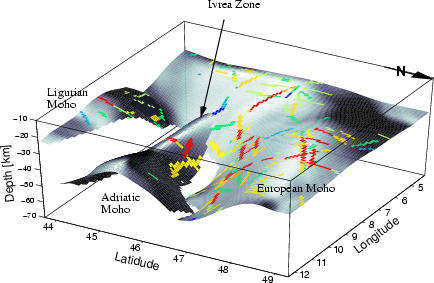Alpine structure

An active research area is the investigation of orogens, the "crunch zone" where two tectonic plates collide, and subduction zones. The three-dimensional depth structure of the larger Alpine area is, due in large part to decades of research conducted by the Institute of Geophysics at the ETH Zürich, by far the best known "root zone" of a mountain chain worldwide. Besides investigating the different rheological behavior of the upper and lower crust and the mantle lithosphere, we also study the driving forces that today account for the continued uplift of the Alps. This research is carried out in close collaboration with other groups including geophysical fluid dynamics, external pagestructural geology and tectonicscall_made.
We use seismic waves of all kinds and wavelengths to image, with the help of seismic tomography, the three dimensional structure of the inner parts of the Earth. We succeeded in combining refraction and reflection seismic results - recording of waves from man-made explosions - with teleseismic data - records of natural earthquake waves - to produce even more precise tomographic images of the deep subsurface. Inputting different wave types together significantly increases the resolution of the tomographic images. In this way, it has become possible to "see" the topography of the boundary between the lithosphere and the underlying viscous asthenosphere beneath the Alps.
The combination of primary (P) and secondary (S) wave tomography is the best method to capture and image the three-dimensional structure of subduction zones. We combine these methods with fluid dynamic and petrophysical modeling. In this way, one can investigate the formation and migration of magma and fluids that are of great importance in the evolution of continental crust.
